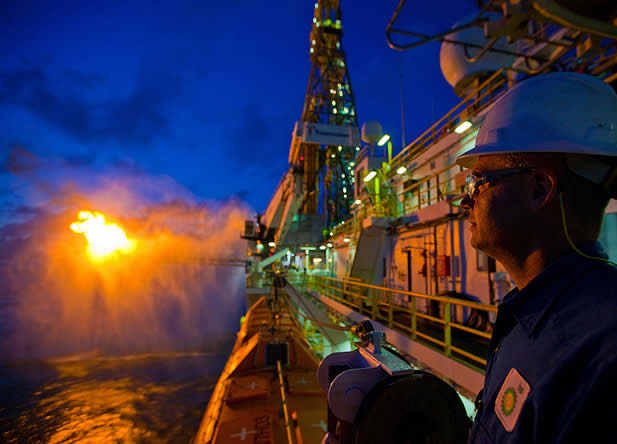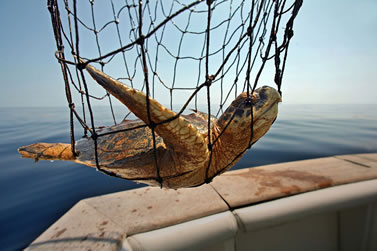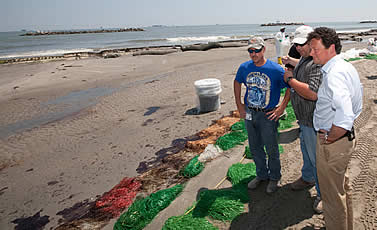Hide and Leak
BP’s Cleanup Is More Like a Cover up. Holding the Company Accountable Will Require Digging for the Truth.

On July 15, BP managed to finally seal its broken Macondo wellhead and stop the oil that had been hemorrhaging into the Gulf of Mexico for 87 days. The very next week, as I was driving up the Florida coast, locals kept pointing out to me where cleanup workers were packing up and pulling out. From Crawfordville through to Carrabelle, and Port St. Joe to Pensacola, the booms were disappearing, the crew tents folded up and removed from beaches.
The well had been capped, after all. The gusher had stopped. Game over. Everyone can go home, right?Not even close. If all goes according to plan, the relief well should provide a more permanent fix. But that hasn’t been the nature of this disaster. Every time BP thought it had the solution, something somehow went wrong. At the time of this writing, at least one oil seep had sprung in the ocean floor near the well as the pressure from the plug found other releases; methane, too, looked to be leaking. And BP was, once again, dodging the government’s requests for more monitoring.
The capping of the geyser will not, unfortunately, mean the end of the Gulf disaster. Don’t forget that it took nearly a month after the blowout for the first oil to make landfall. The oil-and-chemical mix will be coming ashore in the water and on the wind long after the relief well delivers on its promise.
I don’t share that fact to be discouraging, but only to remind us all that, if we turn our backs on the Gulf now, we will lose the high stakes game that started on April 20 when the Deepwater Horizon exploded. And I mean us – because every American has a stake in this game. This contest is about far more than dollars for damages; it’s about our country’s ability to hold big corporate criminals accountable to the public interest and ensure that they follow the laws we enact.
That’s going to be tough, especially given our national attention deficit disorder. The media will lose its focus soon and shift its gaze to the next catastrophe. Politicians will be tempted to move on to other agendas. But the environment may not recover for years. And the political and legal effort to hold BP to its promise to “make it right” will take a decade at least – if not two.
I know this because I am a survivor of the 1989 Exxon Valdez oil spill – and the 20 years of litigation that followed. The experience completely changed my life. I started as a marine toxicologist, became a commercial fisherwoman, and ended up a democracy activist. I helped start three nonprofit organizations to deal with the lingering social, economic, and environmental harm that Exxon claims never existed. I wrote two books: one on the biological impact of the spill, the other on the emotional impact of disaster trauma and the process of healing. Then I saw it begin all over again. It’s strange – discouraging, really – to witness how seamlessly my work went from the Gulf of Alaska to the Gulf of Mexico.
 Carolyn ColeThousands of endangered turtles were affected by the gusher.
Carolyn ColeThousands of endangered turtles were affected by the gusher.Here in the United States, the spiller-in-charge wages a very different war. It’s a war to minimize the spiller’s legal liabilities, which means it’s a war against the truth, the injured people, and the environment. Each decision the spiller makes is filtered through the lens of accounting rather than accountability. BP’s every act is motivated by its desire to reduce its legal and financial liabilities – as was Exxon’s after the spill in Alaska. This is not a moral judgment, it’s just a point of fact. It’s how things work in a system where corporations have one legal reason for being: to make money.
This explains why there are two versions of spill reality: what the spiller says is going on, or the “official” industry-government story, and what is really happening, as told in eye-witness accounts.
I came down to the Gulf on a one-way ticket in early May anticipating the dual reality and committed to highlighting the truth as I found it. I hoped to share experiences from the Exxon Valdez saga with Gulf residents in an effort to help them avoid the mistakes we made in Alaska – mistakes for which we are still paying. I hoped to work in solidarity with communities to help counter the inevitable “official” story. Because correcting the false story is the first step toward accountability. It’s the only way to make BP pay and to avoid the secondary disaster, euphemistically known as the “cleanup,” but more accurately called a cover-up.
It was already an uphill battle by the time I arrived. The broken pipe was spewing under a mile of ocean water. BP was the only one with access to the site and estimates of flow rate. The company’s early estimates inched up as its credibility shot down. One thousand barrels a day… 5,000 a day … 25,000 a day … would you believe 50,000?
It was hard to tell from the video footage BP released. A high-definition, live-feed camera deployed at the leak would have ended the guesstimates, but BP resisted until Congressman Edward Markey, among others, insisted on transparency. Then it turned out that BP and the Coast Guard had been viewing HD video all along.In early June, federal and university scientists estimated a worst-case scenario flow rate of up to 100,000 barrels daily (over four million gallons), most likely from Day One. The scientists and media then settled on an “accepted” rate of 25,000 barrels per day. (By early August, that number had been revised upward yet again to 53,000 barrels.)
Where can people vote “do not accept”? The accepted spill volume for the Exxon Valdez was 11 million gallons (262,000 barrels). But eyewitnesses this was the low-end estimate. Five years after the spill, the State of Alaska released its independent analysis putting the spill at 30 to 35 million gallons.
Underestimating spill volume is common in the oil industry because stiff penalties are based on volume spilled: $1,100 per barrel under normal circumstances. If BP is found guilty of gross negligence for failing to repair the damaged blowout preventer, fines rise to $4,300 per barrel. By the time the Macondo was capped, estimates ranged from 100 million to 200 million gallons of oil blown into the Gulf. That’s a big enough discrepancy for BP to save billions with fuzzy videos.
BP got serious about scrubbing out evidence when it released oil dispersants onto the surface of the ocean and under the water. Dispersants are industrial solvents designed to break up oil slicks into droplets that sink and spread out. In other words, they make oil slicks, and liability, “disappear.”
In late May, when surface slicks began rolling into Louisiana’s coastal marsh, BP CEO Tony Hayward declared, “The oil is on the surface,” a bald attempt to distract attention from the huge amount of oil lurking within the mile-deep water column. He stated that BP had found “no evidence” of the oil-dispersant plumes suspended in large masses and reported by at least three universities.
Alas for BP – and the entire Gulf ecosystem – the persistent plumes became an inconvenient truth. In July, Hugh Kaufman, a senior policy analyst at the EPA, blew the whistle on the industry-government cover-up when he confirmed that nearly two million gallons of dispersant had been applied as of July 20, and 44,000 square miles of ocean were contaminated by the oil-dispersant toxic stew.
The use of dispersants amounts to an experiment of unprecedented proportion on the Gulf’s wildlife and people. Dispersants were developed by the oil industry in response to public outrage when the tanker Torrey Canyon wrecked on England’s coast in 1967. As a budding marine scientist, I researched effects of the first-generation dispersants in the mid-1970s. They were like straight kerosene: They killed everything they touched.
The oil industry went back to the drawing board and, during the next 40 years developed successive generations of less toxic dispersants. The problem is that dispersants are dangerous by nature. They are solvents, which means they can dissolve oil, grease, and rubber. Workers on the Vessels of Opportunity (the lemons-into-lemonade name given to BP’s cleanup fleet) have told me that their hard rubber impellors are falling apart and need frequent replacement; divers say they have had to replace the soft rubber o-rings on their gear after dives in the Gulf.
Unfortunately, replacement is not an option for the Gulf’s once plentiful denizens – the dolphins, sea turtles, whales, fish, birds, and manatees that make the place home. In May and June, I frequently heard about sightings of dying wildlife or distressed animals fleeing into coastal areas. The first reports came from the offshore cleanup workers and pilots who discovered carcasses concentrated by rip currents, and windrows of dead dolphins, turtles, and birds “too numerous to count” on barrier islands.
Such evidence is rare because BP, and its puppet the Coast Guard, pushed cameras away from the spill, then away from beaches. On June 2, I was flying on a charter from New Orleans to Orange Beach, Alabama, when the straight orange lines delineating FAA’s flight restriction zone jumped onshore to include Alabama’s beaches. The shocked pilot shook his head and said, “There’s only one reason for that: BP doesn’t want cameras on the beaches.”
The situation reached a new low when the Coast Guard ignored the First Amendment and said anyone who got within 65 feet of response operations without government permission could face felony charges and up to $40,000 in fines. That policy, and other unwritten forms of censorship, have been aggressively enforced by BP’s private security teams and local police who commonly work off-duty (in their uniforms) for BP.
Retired Coast Guard Admiral Thad Allen, the person allegedly in charge of the cleanup, said the restrictions were intended to protect “safety.” Really? If the federal government or BP were so concerned about safety, then maybe any of the four agencies – EPA, OSHA, NIOSH, or the Coast Guard – that are supposedly sampling air and water quality should design better monitoring programs. None of those agencies has found unsafe levels of oil or the notorious human health hazard, 2-butoxyethanol, a primary ingredient in one of the dispersants (the ironically named “Corexit”) dumped into the Gulf. But plenty of other people have discovered dangerous chemical levels in the environment.
For example, about a week after the oil started coming ashore in Alabama, the Mobile television station WKRG took samples of water and sand from Orange Beach, Gulf Shores, Katrina Key, and Dauphin Island. The test was nothing fancy. The on-air reporter simply dipped a jar into the ocean and another into some surf water filling a sand pit dug by a small child. In the samples, oil was not visible in the water or the sand, but the chemist who analyzed them reported astonishingly high levels of oil ranging from 16 to 221 parts per million (ppm).
Except for the Dauphin Island sample – that one exploded in the lab. The chemist thought maybe the exploding sample contained methane or 2-butoxyethanol.
These levels of oil could explain the bouts of skin rashes I heard about from coastal residents, pharmacists, and medical doctors in Louisiana, Mississippi, Alabama, and Florida. The rashes ranged from a fiery red discoloration to deep blistering. The worst cases I saw were on the legs of offshore cleanup workers who were diagnosed by BP with “staph infections.” Sick workers who sought out independent doctors were fired, according to the workers.
Toxicologists and medical doctors told me that oil alone would not cause deep blisters and scarring – but dispersants could. There is also evidence of dangerous levels of oil in the air. What people described as “invisible jellyfish” in the water became “stinging rain” in the air. I suspect the sting is from the micelles, little oil bubbles wrapped in solvent. A preliminary study commissioned in mid-July by Guardians of the Gulf, a community-based nonprofit organization in Orange Beach, Alabama, found that nightly air inversions – common in the area during the summer and fall – were trapping pollutants near the ground. Total Volatile Organic Compounds (VOCs) – including the carcinogen benzene, and oil vapors – reached 85 to 108 parts per million at 9:00 a.m. but rapidly dropped to zero (or non-detectable) within half an hour as the sun burned through the inversion layer. This would help explain why the EPA has failed to detect VOCs with its own tests: The agency typically does its sampling during the daytime.
The high VOC levels could explain the bout of respiratory problems, dizziness, nausea, sore throats, headaches, and ear bleeds I’ve heard about from residents and health professionals from Houma, Louisiana, to Apalachicola, Florida. Even the oil industry knows that these chemicals are unsafe. As long ago as 1948, the American Petroleum Institute confirmed that “the only absolutely safe concentration for benzene is zero.”
And yet throughout the entire debacle, the regulators with OSHA have refused to require respirators for offshore cleanup workers, arguably the most at risk from high exposure levels of oil-dispersant contaminants. Under public pressure, OSHA finally insisted respirators be provided to offshore workers (only), yet the agency well knows that BP has consistently informed cleanup workers that wearing respirators will result in job termination. Why would BP be opposed to such an easy and cheap worker protection measure? For the same reason the company chases cameras off the sand – it doesn’t want to look bad. Workers wearing respirators would be an admission that something is terribly wrong, and leave BP open to long-term medical surveillance.
What will become of the Gulf? If the experience of Alaska’s Prince William Sound is any indicator, the future will be grim. Holes will appear where once things were solid. There will be holes in the Gulf’s ecosystem when the 2010 class of young sea life fails to return as adults, just as in Alaska, where the Prince William Sound herring fishery still remains closed. There will be holes in Gulf communities as depression crimps lives and families leave, just like what happened in my town of Cordova. There will be holes when the false economy propped up by BP’s cash crashes to the reality that this tragedy has stolen much of the Gulf’s economic foundation.
 BP AmericaBP CEO Tony Hayward lost his job over the Macondo disaster, thanks in part to
BP AmericaBP CEO Tony Hayward lost his job over the Macondo disaster, thanks in part toinappropriate soundbytes like, “I just want my life back.”
Accountability was something we failed to achieve in Alaska. It took me almost 20 years – and a lot of personal growth – to fully understand why. Over time, I began to see that Exxon’s oil spill wasn’t an environmental disaster; it was, instead, a democracy disaster. Exxon’s collusion with the government then, like BP’s today, made it blatantly obvious that “We the People” have lost control of our Republic. When government decides that bowing to the needs of companies is its top priority, disasters that come at the public expense are the natural result.
This was true before, but in the wake of the Gulf spill it’s plain for everyone to see. As one of my new friends in the Gulf put it: “This is not new. This is just in our faces.” The righteous anger in that statement might yet be able to mend the holes in our democracy. It might give us the chance to put our political divides aside and work together to reclaim government of, for, and by the people.
Riki Ott is author of Not One Drop (Chelsea Green, 2008) and director of Ultimate Civics, a project of Earth Island Institute. She is a member of the national grassroots coalition MoveToAmend.org.
No comments:
Post a Comment
Please keep comments free of vulgarity. Your message will be deleted if not.
This thing is vulgar by it's self.